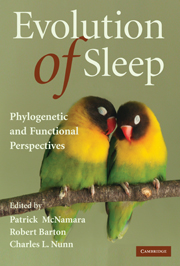Book contents
- Frontmatter
- Contents
- Contributors
- Acknowledgments
- Introduction
- 1 Ecological constraints on mammalian sleep architecture
- 2 Sleep in insects
- 3 Schooling by continuously active fishes: Clues to sleep's ultimate function
- 4 What exactly is it that sleeps? The evolution, regulation, and organization of an emergent network property
- 5 Evolutionary medicine of sleep disorders: Toward a science of sleep duration
- 6 Primate sleep in phylogenetic perspective
- 7 A bird's-eye view of the function of sleep
- 8 The evolution of wakefulness: From reptiles to mammals
- 9 The evolution of REM sleep
- 10 Toward an understanding of the function of sleep: New insights from mouse genetics
- 11 Fishing for sleep
- Index
- Plate section
- References
11 - Fishing for sleep
Published online by Cambridge University Press: 10 March 2010
- Frontmatter
- Contents
- Contributors
- Acknowledgments
- Introduction
- 1 Ecological constraints on mammalian sleep architecture
- 2 Sleep in insects
- 3 Schooling by continuously active fishes: Clues to sleep's ultimate function
- 4 What exactly is it that sleeps? The evolution, regulation, and organization of an emergent network property
- 5 Evolutionary medicine of sleep disorders: Toward a science of sleep duration
- 6 Primate sleep in phylogenetic perspective
- 7 A bird's-eye view of the function of sleep
- 8 The evolution of wakefulness: From reptiles to mammals
- 9 The evolution of REM sleep
- 10 Toward an understanding of the function of sleep: New insights from mouse genetics
- 11 Fishing for sleep
- Index
- Plate section
- References
Summary
Fish comprise about half of the known vertebrate species. The vast majority of the extant 30,000 currently known species of fish are bony fishes. They occupy diverse habitats in fresh and salty waters of rivers, lakes, seas, and oceans. The dynamic adaptations of fish to these distinctly different environments – including complex reproductive, migratory, and life-cycle adaptations – are truly remarkable. Their adaptive strategies include periods of rest that, in different fish species, can be spent lying quietly on the sea floor, floating, or swimming.
With fishes as with other phylogenetically earlier animals discussed in this book, the decision as to whether they actually sleep or just rest quietly must be based on a combination of behavioral features, electrophysiological patterns of brain activity, and molecular processes that we associate with sleep in mammals. Sleep is thought to be present when the animal is in a species-specific posture of behavioral quiescence and exhibits elevated arousal thresholds as well as rapid reversibility of behavioral quiescence after appropriate stimulation (Campbell & Tobler, 1984). The majority of fish species thus far studied display these behavioral features of sleep accompanied by physiological quietness, including reduced heart rate and respiration (Karmanova, 1975; Karmanova, Churnosov, & Popova, 1976; Karmanova, Titkov, & Popova, 1976; Peyrethon & Dusan-Peyrethon, 1967; Shapiro & Hepburn, 1976; Tobler & Borbély, 1985).
- Type
- Chapter
- Information
- Evolution of SleepPhylogenetic and Functional Perspectives, pp. 238 - 266Publisher: Cambridge University PressPrint publication year: 2009



